
James Johnson is a modern day artist on the rise pulling from thousands of years of his Tlingit heritage to shape incredible works in wood, paint, cloth or other mediums. (visit www.jamesjohnsonnativeart.com) He’s also a life long snowboarder, a “Juneau Boy” who grew up ripping Eaglecrest with some of the best to do it (including his close friend Mark Landvik). We’ve been extremely lucky to work with him on Pete Saari’s dream board project the Double Dip for 3 years now. To celebrate the release of another beautiful board we asked James to answer some questions about his art and heritage. James is an amazing human doing great stuff and this is a must read!

Questions by Pete Saari
Can you tell us a bit about where you are from? – You are of Tlingit heritage can you share a bit about your culture?
I am Tlingit Indian from Juneau, AK. I belong to the Dakl’aweidi Clan (killerwhale clan), my family lineage is from the Xutsnoowú Kwaan (Angoon, AK). My Tlingit name is Onn-iss-kwah – means “man who stands along strong.” This name was given to me by my grandfather Chief Peter Johnson. My Grandfathers were all Dakl’aweidi Chiefs of Xutsnoowú. My great great Grandfather as Chief Gusht’eiheen – which means “Spray off the Dorsal Fin” (Killerwhale).
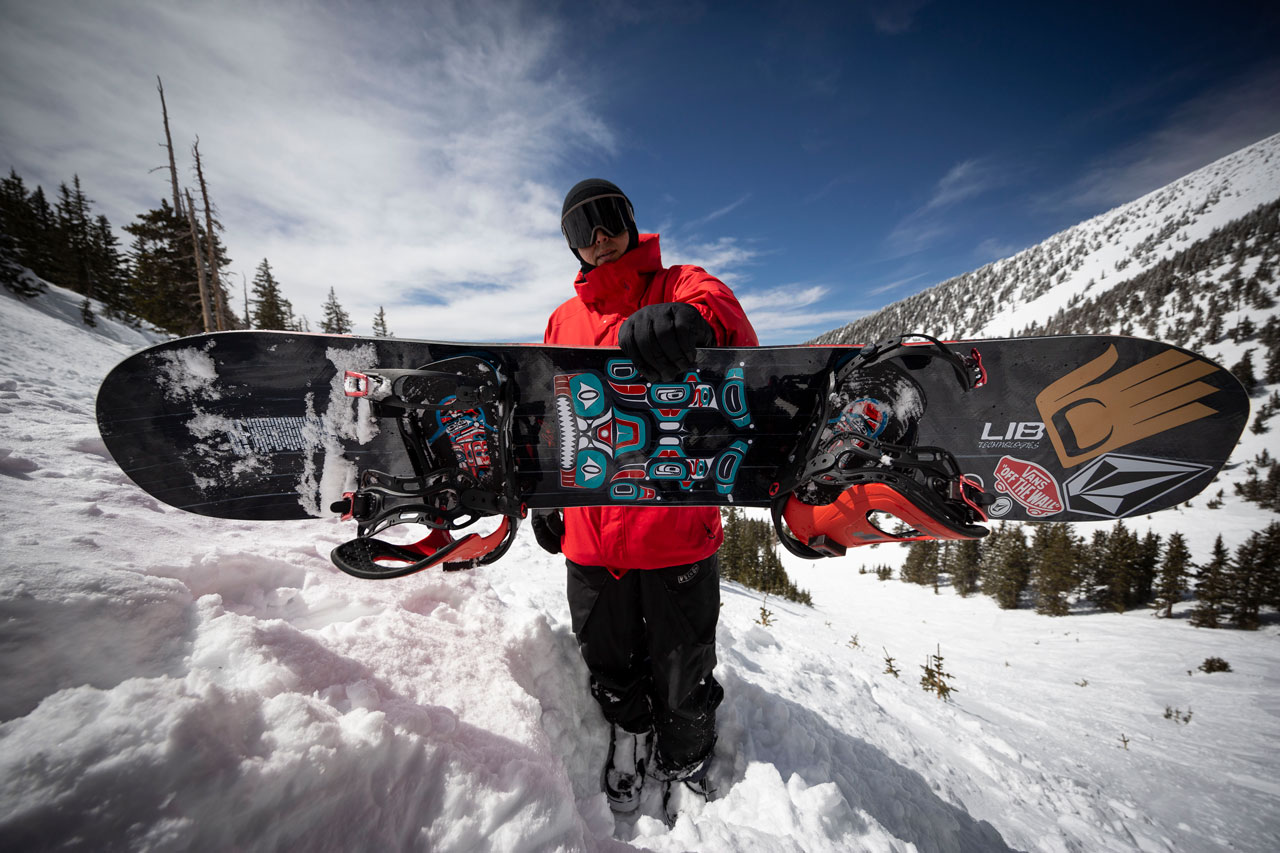
You are keeping the beautiful traditional formline and carving arts of your people alive and sharing it with all of us. What inspires you?
The Tlingit Art form is thousands of years old, this art form was created by my ancestors in southeast Alaska. There is no word for “art” in our language, the “art” you see was integrated as completely part of our culture and the way we lived. The history of our people is an oral history, our stories are past down from generation to generation, and the art was an integral part of telling this story and our history. The work that I do honors this tradition, and carries it forward thru my lifetime. I’m really fortunate, whether I chose this, or it chose me, this is what I’m supposed to be doing with my life. I was carving on a trip in Alaska, and I had an elder tell me “your ancestors are smiling down on you.” That makes me emotional everytime, it made me cry when she said that. I’m on the right path, I love what I do.
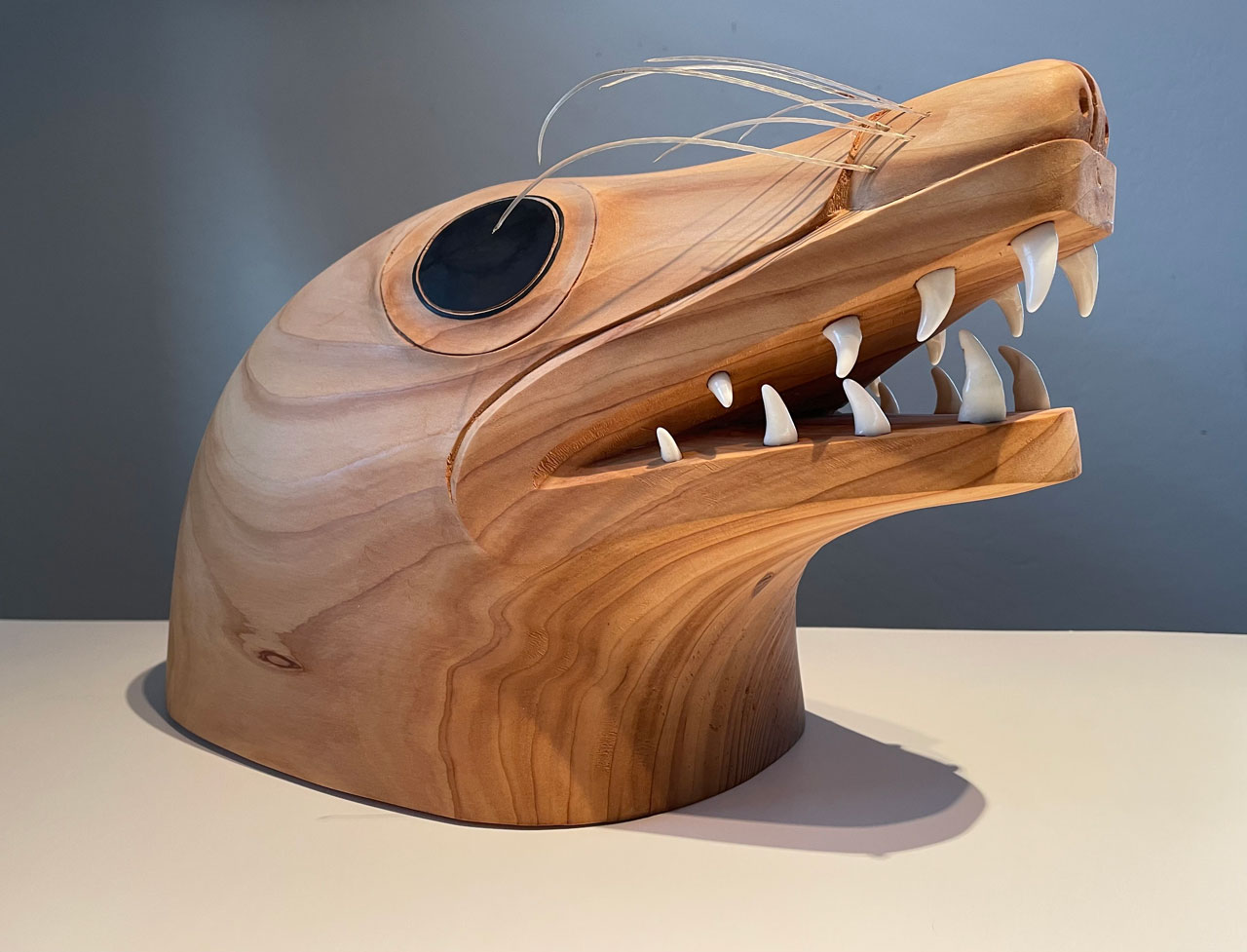
Did you have teachers or mentors that helped you learn your craft?
The work of my ancestors set the standard for what all Northwest coast artists are striving towards today, we are not there yet. They were the true masters, highly skilled. We have every tool imaginable today, but the reason why their work is so much better than ours is because they had this tremendous knowledge that was passed down thru generations. I taught myself the fundamentals of the Tlingit art form, a lot of artists can’t believe that. It took years and years of studying, drawing everyday, late nights carving, a ton of work that no one sees. But, I owe a lot to Nathan Jackson, he is one of the best all-time Tlingit artists living. Bill Clinton declared Nathan a national treasure when he was in office. Nathan selected my work to be featured in the Celebration Juried Art Show in 2012, featuring the top Tlingit, Haida, and Tsimshian artists. It was an honor to have my work selected by Nathan, I was so excited. After the show, I asked him to critique my work. He said, “look, you’re good, I see your potential, but the work you’re doing right now is garbage.” Hearing that from your all-time idol was crushing, but it was what I needed to hear. I think more people need to hear things up front, straight honest truth you know. But, he told me what I needed to do, and he put me on the right path of building a solid foundation. What I do is a life-long learning experience, you’re never going to fully master it, you work everyday to get better, it’s a never ending process. Our Tlingit belief was if they saw a Tlingit carver who was naturally gifted, they believed he was a re-incarnation of a previous carver’s life. To have this natural ability. But, the way I see it, my ancestors placed this gift into my hands, I’m going to make the absolute most out of it.

Keeping your culture alive and sharing it with the next generation feels like very important life work what does that mean to you and do you and do you have younger artists you work with?
I love the fact that all my work will outlive me. You’re leaving your mark with each piece, for future generations to see and learn from. Traditionally, our knowledge was passed down from generation to generation. This was our way for thousands of years. The moment a young boy showed talent or interested in Carving, he immediately became an apprentice under the master carvers in his clan, and learned to preserve his culture and heritage thru the art. This was vital, as a carver, you were highly regarded amongst your clan. The work you do is carrying forward the history of our people. It’s a big responsibility to take. Aspiring carvers reach out to me all the time, I answer and encourage every single one of them. I was just like them at one point, I know how it feels to have this enthusiasm to want to learn, wondering where to start. I do my best to get them on the right track, and stress the importance of patience. You don’t carve a mask in one stroke of your adze, like you don’t climb a mountain in one step, it takes a lot of small steps to get there. Looking back at the work of our ancestors is best to learn, they were the true masters. Study as much as possible, absorb everything. I am also an instructor at the Port Townsend School of Woodworking, I’ll be teaching Tlingit Carving this year, and next year. Passing on what I know, helping others succeed is a gift.

Are there any key defining aspects of Tlingit art? Is there a difference between Tlingit the art work and neighboring cultures Haida and Tsimshian art work?
Tlingit, Haida, and Tsimshian art are considered the “Northern Style” of art. Our formline design are all very similar visually, lines and colors look similar, but we each have our own language, stories, etc. But, there are differences in style. Tlingit has bold, broad, formline design, and our carving style is specifically styled. The foundation is always our style of formline, the composition of our lines, balancing negative and positive space, and colors we use. As you go further down the coast, the art form changes even more so, the formline style changes, colors, etc. You learn the fundamentals of the art form, but after years of practice you develop your own style within the art form. It’s like your signature without signing it, you can tell who did it.

Where and how did you start snowboarding?
I grew up snowboarding in Juneau, AK, learning to snowboard at Eaglecrest. Original crew was Bubba Weedman, Dave Fermin, and Lando was the young buck in the crew. We’d ride every weekend together. The terrain at Eaglecrest shapes you into a really strong rider that can handle anything, so many good snowboarders grew up riding that mountain. It’s a special place.

Who is your shred crew on a perfect day?
A Perfect day would be back home in Alaska at Eaglecrest, hiking ridge on a blue bird day, getting first tracks then lapping the whole mountain with the homies. But, this past year my son Elias is learning to snowboard. We got off the bunny hill, and he took his first real chair lift ride up. That was magical, there’s nothing like riding the chair up with your son. That’s the perfect day.
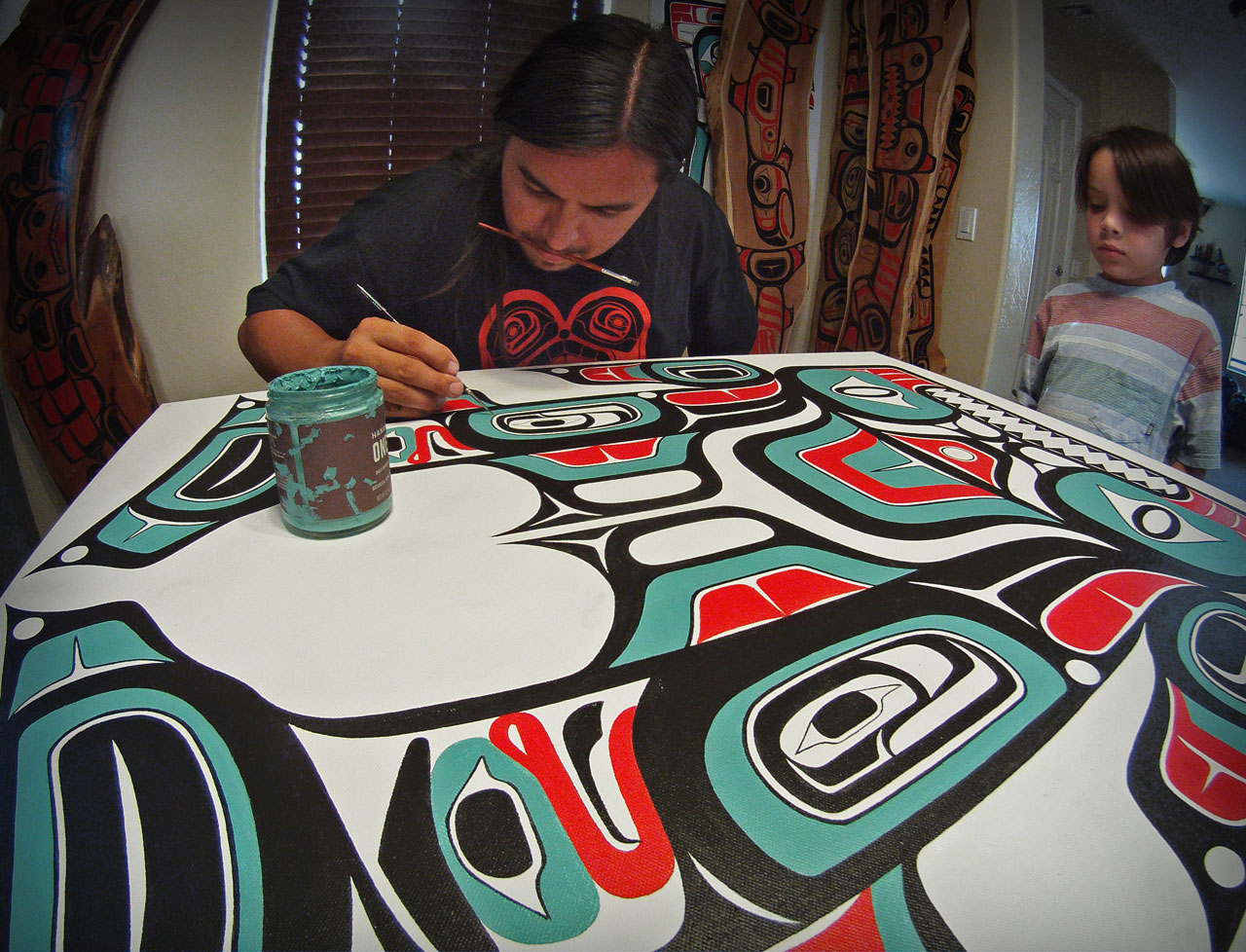
Is there something about your culture or art you would like everyone to know?
Colonization – learn the true history of what really happened to our people. It’s not taught in schools. Currently, we are in a pandemic, people are losing loved ones, it’s tragic and sad. In the 1800’s, Smallpox wiped out 3/4 of the Northwest Coast Population, you can relate that to what we’re going thru now. I think of how many artists died without passing on the knowledge they had. Sad. Then the ones that did survive, their children were taken from them and placed into residential schools filled with abuse, their culture stripped from them. The foundation of Tlingit culture and society is our Ku.éex’ – our potlatch. A Ku.éex solidifies an event, it was our notary public. By rule of the government and church, our Ku.éex was banned. You’d be thrown in jail for carving, dancing or singing. Art was destroyed or taken, scattered all over the world. Lost. It was full cultural assimilation. Everything that could have been done, was done to destroy our way of life.
Today, we are picking up the broken pieces we have left and putting them back together the best way we know how. What I do is so much bigger than creating something that looks beautiful. I’m carrying on the tradition and culture of my ancestors, this weight is on my shoulders. It is my responsibility to honor and respect my heritage.
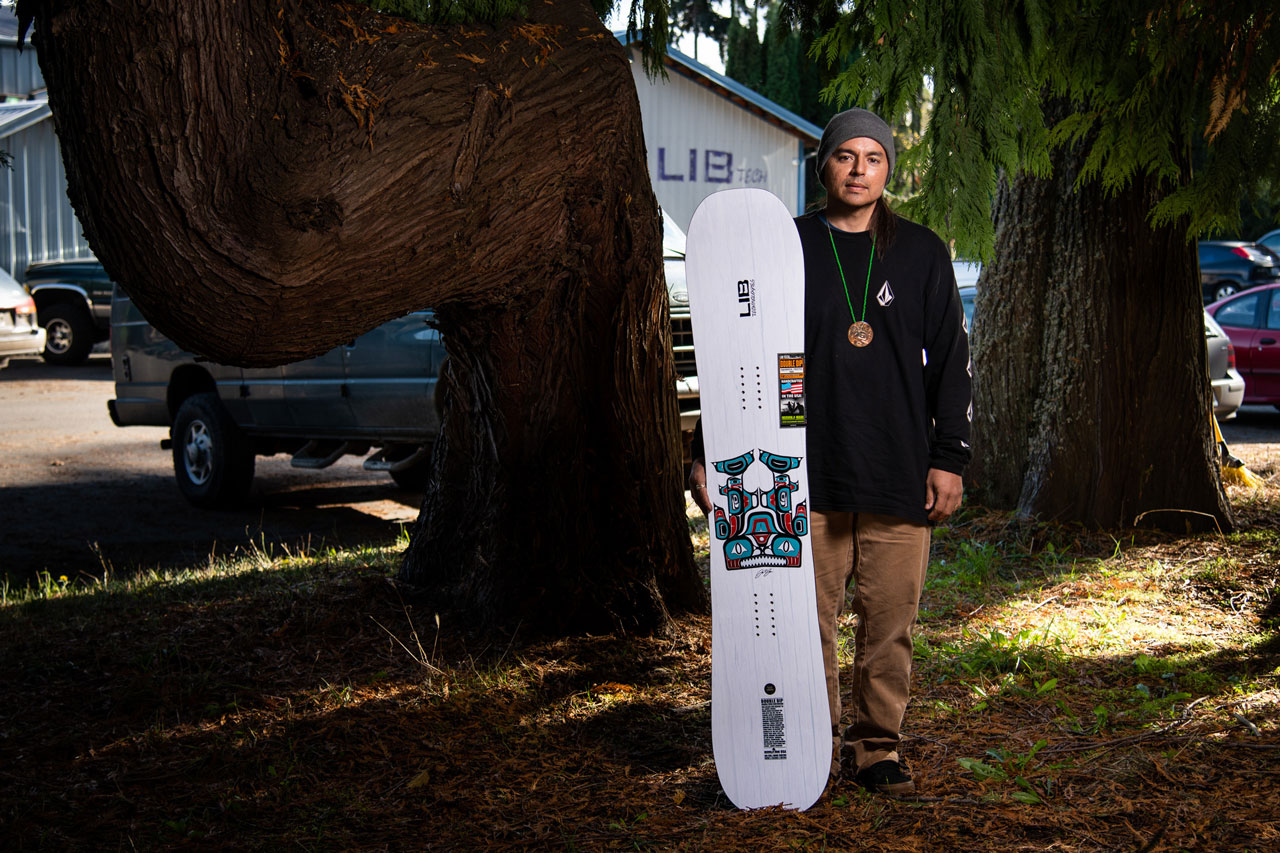
We have been very honored to work with you on the Double Dip project can you share about this year’s shark artwork?
My late father Franklin Johnson belonged to the Yeil L’eeneidi Clan (Shark clan). He first encouraged me to learn how to carve. He passed away, and I wanted to paint his clan crest to honor him. It’s special when I do Shark designs, I think of him often during the process. My dad taught me not to get attached to my work. This was the teachings of our traditional ways, like when carvers finished a kootéeyaa (totem pole)- they could no longer touch it. It didn’t belong to them anymore, it belonged to the people. When you finish a piece, you give it life. You let it go where it needs to. I’m happy it became a graphic for the Lib Tech Double Dip. Truly an honor.

Is there a way people can see more of your artwork?
You can see photos of my process and finished pieces on my Instagram @jamesjohnsonnativeart – or my website www.jamesjohnsonnativeart.com. I have pieces in museum collections across the country, The Art Institute of Chicago, The Denver Museum of Nature and Science, The Heard Museum Gallery here in Arizona, Sky Harbor Art Museum in Phoenix, the US Dept of the Interior Museum in South Dakota and Washington DC.

We have been able to donate some of the proceeds of the Double Dip to the SeaAlaska Heritage Institute you work with. Can you tell us a bit about where SHI is and the your involvement with it? Is there a way others can visit or contribute?
Sealaska Heritage Institute is located in my hometown of Juneau, AK. ( www.sealaskaheritage.org @shinstitute ) They are constructing an Arts Campus that is going to teach Tlingit, Haida, and Tsimshian Arts and Language. Really incredible organization. I’ve been involved with the Sealaska Celebration Juried Art Show for a few years now. It’s always an honor to have your work featured amongst my peers, artists I look up to. SHI is working to make Juneau the art capital of the world for Northwest Coast Art. It’s incredible Lib Tech gave back and helped sustain the art for future generations to come.

Lakt Bentwood Box (unfinished here) – Red Cedar
You have done some big projects with the Smithsonian Institute and the US Department of the Interior…can you tell us a bit about those and any upcoming projects you have going?
My dad told me to focus on your skill, be able to pick up any piece of wood and create something out of it. Your skill is most important. I believe that you focus on doing good work, put out positive energy and then you attract things to you. I believe that process. It’s humbling to receive commissions from these places, at times it seems unreal. But, also, I’ve put in the years of work, so it’s happening the way it should. You trust your ability.
As far as upcoming projects, I’ve been working with the US Dept of the Interior this past year and a half, they’ve acquired pieces for their museum collections in both DC and South Dakota. The curator in DC said 2 of my works are going up in Secretary Deb Haaland’s offices in DC. Incredible. I also have a solo museum exhibition opening in South Dakota in November thru the US Dept of the Interior. I’ve been working non-stop on pieces for that exhibit, that’s like a dream for sure.
I just signed a contract to be an ambassador for Smartwool, I’m excited to be associated with such an amazing brand. Huge thank you to Alex and Dana at Smartwool.
I’ve also been working with Vans on an upcoming project for 2022. The team at Vans is so incredible, couple years in the making. Huge thank you to Matt Patti – he’s an awesome human being. Amazing company, I’m really excited.
I was approached to be a part of a book called “Contemporary Tlingit Art” – covering 30 Tlingit artists over the past 40 years. It’s an honor to share my work in this, it’ll be published by Washington Press, released in 2023.
Working on an art collab project with John Gourley from Portugal The Man. The work they’re doing for indigenous people is amazing, providing a platform for our voices to be heard. @portugaltheman
I’m going to do a project with Slowtide – www.Slowtide.co – Really impressed by their company and aesthetic. Dario is a solid guy, excited to work with them.
No projects, but I want to shout out Ryan Immegart and Kalin Cassidy at Volcom. They’ve supported me for a few years now, such a cool company, promoting creative expression, individuality, and art. My son loves to wear the gear too, amazing company.
I just talked to Lando, he’s a person who changed my life, one of the first people to believe in my art. But, we’re going to get some new gear out for N-Grained Inc. soon. And probably line up something for Natural Selection this year also. Hyped for that. www.ngrainedinc.com
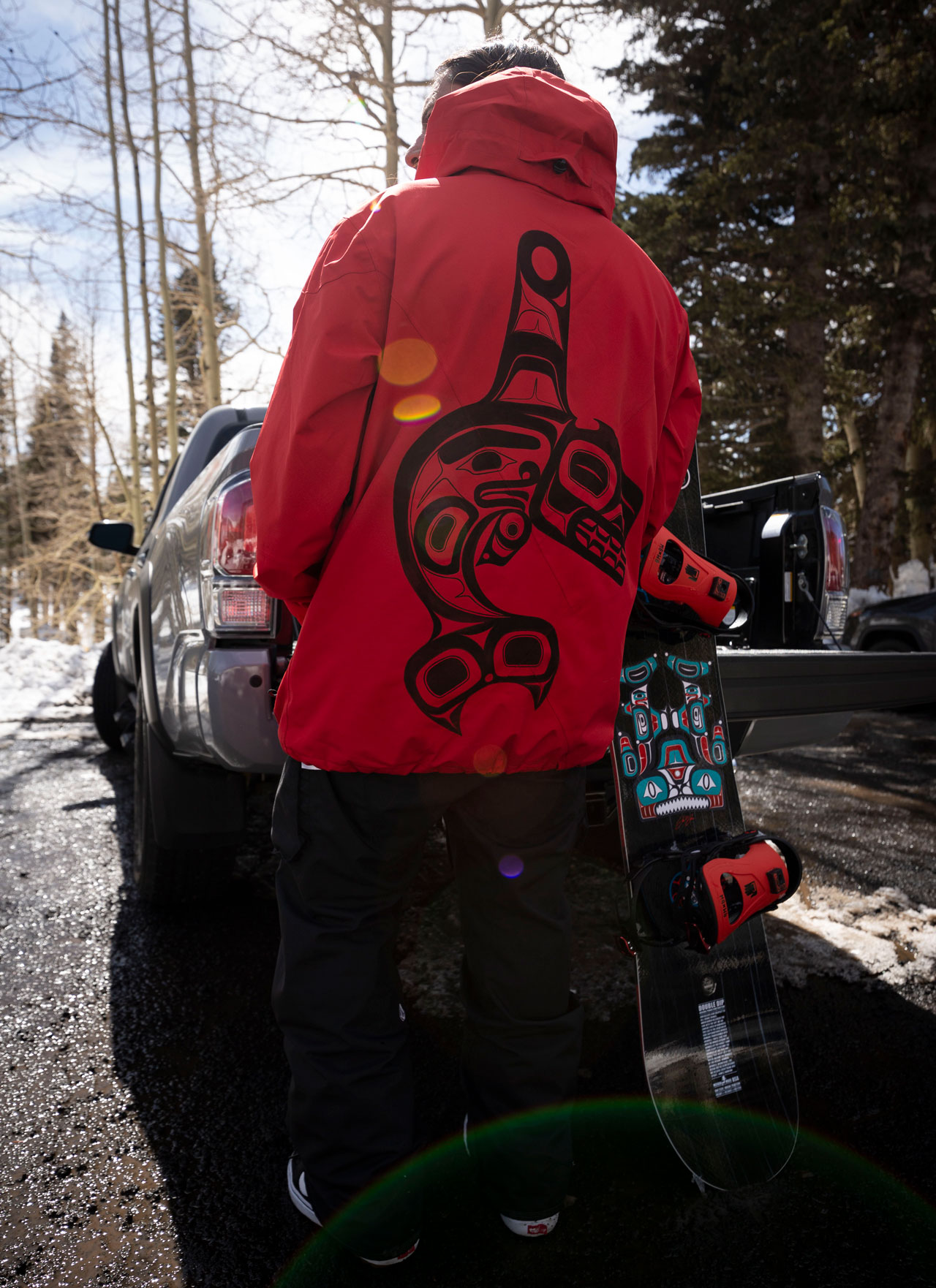
Thanks for being so kind and sharing your amazing work with us all. It’s an expansive topic but, do you have any thought’s about how all of us can recognize, celebrate and help North American native cultures thrive in our modern times we would love to hear your perspective
Our traditions honor the Earth. You give respect to all things. Nothing is better than the other, everything has spirit. We lived in this beautiful balance, balance with the earth, our societal structure and beliefs. You can not take without giving. Professor Stephen Langdon of University of Alaska Anchorage best describes our culture as “Obligatory Reciprocity.” It’s about balance. Our clan structure is Eagle and Raven are our 2 top clans. Our culture is matrilineal, you follow your mother’s clan and then marry the opposite. My mother was Eagle, so I’m Eagle, and my wife is Raven, and my son is Raven. This preserves the balance. The Tlingit word for potlatch is Ku.éex – which means to give. These days, you can see how much we are taking from the earth. You can see how out of balance we are with the environment and with each other. Taking more than we need. As a whole, consciously we need to learn the teachings of the old ways, live in balance with all things, honor and respect the earth.
Visit www.jamesjohnsonnativeart.com for more amazing works.
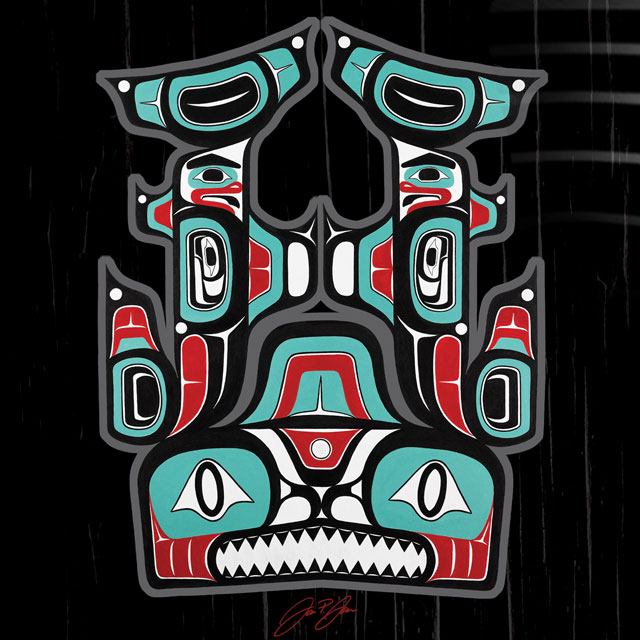

About Double Dip Art:
Our beliefs give respect to all living things. When raven released the sun into the sky, we no longer lived in darkness, this led to the creation of our supernatural world. Humans transformed into animals, those that ran into the woods became the animals of the forest, some took flight to become the animals of the sky, and those that went into the water, became the animals of the ocean. Humans, animals, mountains, the ocean, are all alive because we believe everything has spirit.
~James Johnson
